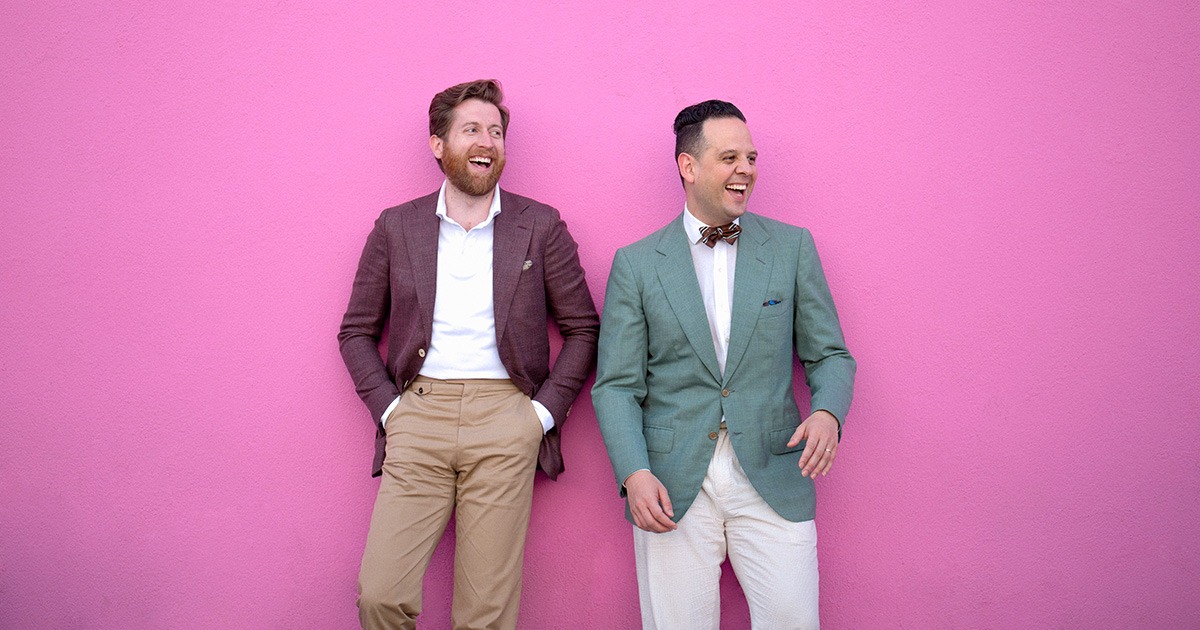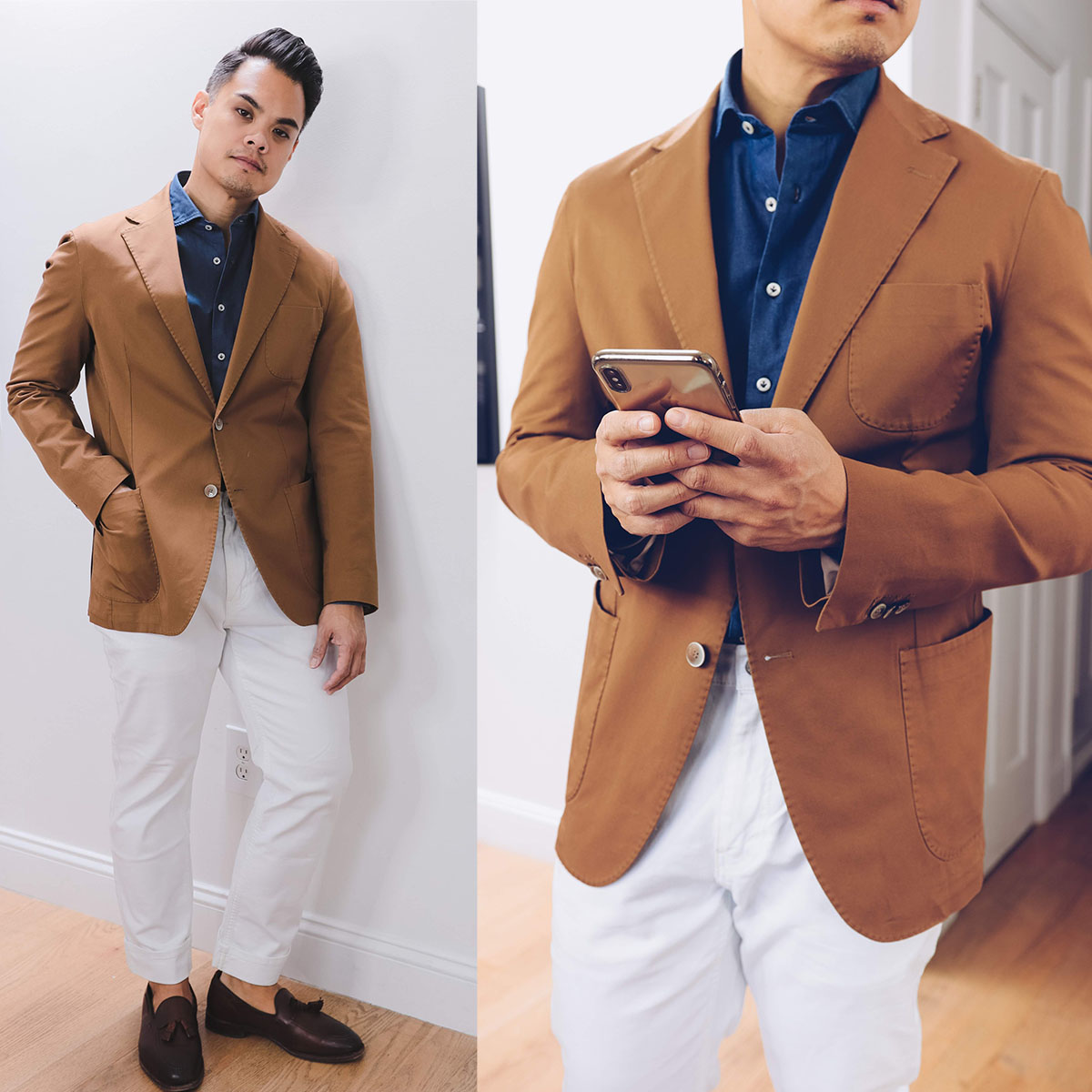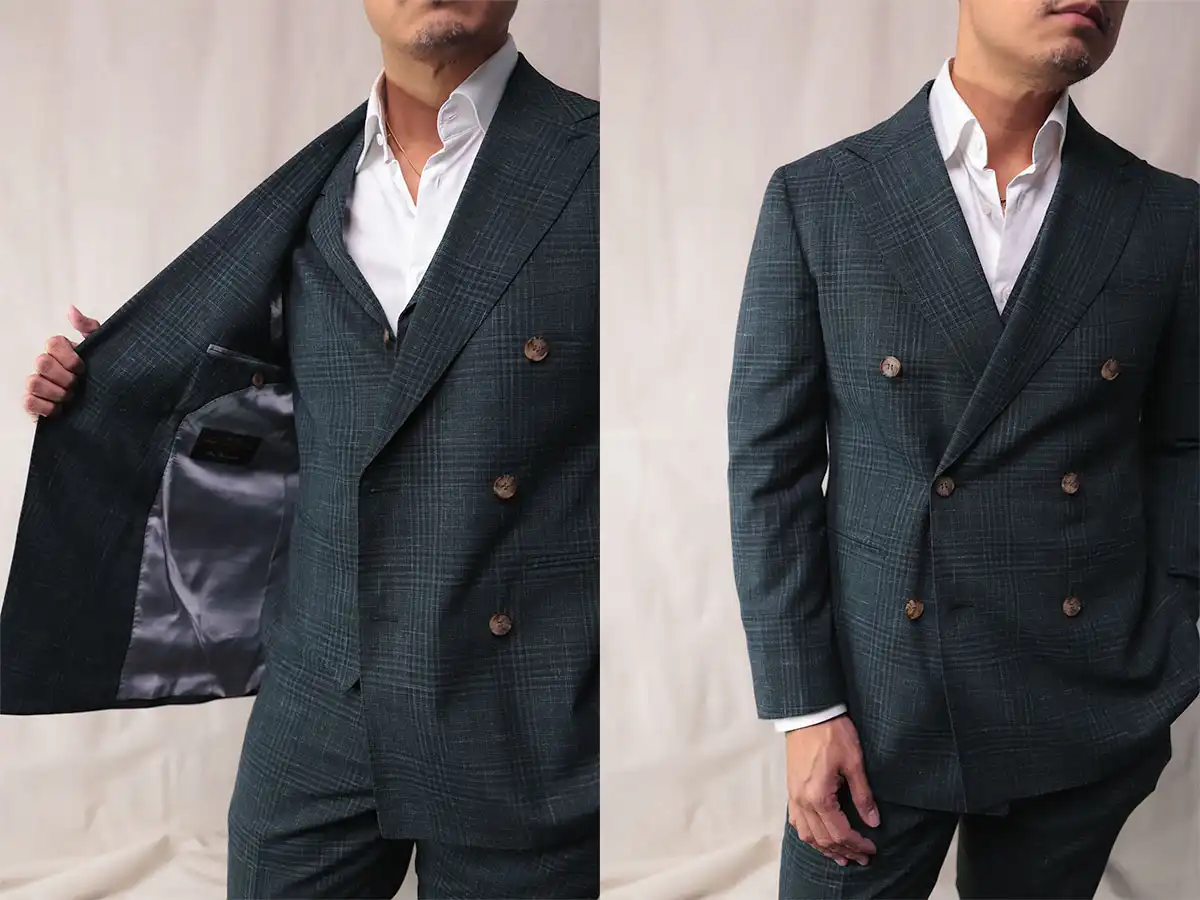You love the idea of wearing a suit, but don’t have that many occasions to don the entire getup. You’d wear the suit jacket on its own… but can you actually wear a suit jacket with jeans? What about with chinos, or another pair of trousers?
Short answer: YES. Longer answer: Yes, but it depends on the type of suit you have.
Let’s get into the details here so you can rest assured you’re wearing your suit jacket with jeans correctly.

How Versatile Is Your Suit?
A good friend of mine traveled home to California last summer to attend a wedding. There was a semi-formal rehearsal dinner the night before, and in the interest of packing light, he asked me if it would be weird to wear his suit two days in a row.
My quick answer was no, not weird at all… just make sure to wear two different
But this got me thinking: How versatile is a suit, exactly?
I then realized, you, the reader, probably have other questions, such as:
- Is it really worth the investment, even if you’re not a guy who wears
suits every day? - How many days in a row can you wear one suit?
- To get more use out of the suit, can you wear the jacket and trousers separately (aka the Broken Suit)?
- How would you wear a suit jacket with jeans / chinos, or the suit trousers with a casual jacket? Basically, how do you take a suit from formal to casual and back again, if necessary?
Let’s tackle these questions one at a time.
Check These 5 Things On Your Suit
If you look this up in The Book Of Style Rules*, traditionally, it’s not correct to break up
However, the general consensus nowadays is that it looks just fine when done correctly. In fact, this practice is widely accepted and actually looks great (again, if you do it right).
What it comes down to is how formal or casual your suit is. The more casual elements it has, the more likely it can be worn separately.

So take a look at your suit and make sure these five things match up. If so, then there’s a good chance you can wear the suit jacket with jeans (or the trousers with a casual jacket, or any other combo you come up with).
Note: Don’t take any one element as a hard-line YES, this can be worn separately, or NO, this cannot be worn separately. It’s about the number and combination of these elements in one jacket… the more of these you have, the higher the likelihood it’s a casual-leaning suit that you can break up and wear separately.
The suit’s fabric
✔︎ Can Wear Separately
- Flannel
- Heavier wool
- Tweed
- Cotton / Linen
- Springy, thicker fabrics with noticeable texture
✘ Cannot Break Up
- Worsted wool
- Cashmere
- Silk
- Fabrics that are smooth, shiny, or have a slight sheen
Worsted wool is probably the most formal and traditional fabric among the
Flannel, tweed, cotton, and linen fabrics are easier to wear casually because of their texture and appearance.
By the way, linen jackets will work nicely in the warmer months, and tweed in the colder months. You’ll find both as sport coats you can wear with trousers, chinos, or denim.
The Suit’s Buttons
✔︎ Can Wear Separately
- Gold, silver, pewter buttons
- Contrasting horn or shell buttons
✘ Cannot Break Up
- Non-contrasted buttons
- Dark buttons on dark cloth
The more contrast your buttons have in comparison to your jacket’s fabric, the more likely you can wear it as a separate.
So if you have gold, silver, or pewter buttons like on a classic navy blazer, these jackets can be worn on their own. If your jacket has contrasting horn or plastic buttons, there’s a good chance the suit can be worn separately, as well.
When your suit jacket’s buttons match closely to the jacket, or are of low contrast, this gives off a more formal vibe, and it’s likely you shouldn’t wear this jacket as a separate.
The Suit Jacket Pockets
✔︎ Can Wear Separately
- Patch pockets
- Patch flap pockets
- Flap pockets
✘ Cannot Break Up
- Flap pockets
- Jetted / welt pockets
Patch style pockets are considered the least formal, which help if you’re dressing the jacket down and wearing as a sport coat. If you own a tuxedo or a more conservative, traditional style suit, you’ll most likely find jetted or flap pockets.
Notice that flap pockets are in both lists. That’s because flap pockets straddle that line between formal and casual. You can find this pocket style on both
So you’ll have to use other elements—not just pocket style—to determine if your suit jacket can be worn with jeans or chinos, and not just the trousers they match with.
The Suit’s Pattern and Texture
✔︎ Can Wear Separately
- Bold patterns (check, wide stripe, houndstooth, etc.)
- Rougher or more tactile textures (seersucker, tweed, springy, heavier wool)
✘ Cannot Break Up
- Cloth with a slight sheen
- Any fabrics with a smooth, shiny texture
- High “super” count worsted wools
If you have a boldly-patterned suit—think a large check pattern, or a houndstooth, etc.—generally, you’d be okay wearing the jacket on its own.
Pinstripes, though a bold pattern, is the one exception to this rule. Pinstripes are generally considered more formal, and the jackets don’t always stand on their own very well. Again, it all depends, but if you’re unsure, I’d stay away.
Fabric texture can also determine if the jacket can be worn on its own. If the fabric has a slight sheen, or if it’s a fine wool, it’s best to wear the suit pants with the jacket. If the cloth has more texture such as tweed, linen, and birdseye, then there’s more of a possibility the jacket can stand on its own.
The Suit Fabric’s Color
✔︎ Can Wear Separately
- Bold, bright, or multiple colors
✘ Cannot Break Up
- Darker colors
If you own a bold or brightly colored suit, or really, any color that isn’t within your standard business color palette—charcoal, navy, black, brown, tan—generally, the jacket can be worn separately.

A Quick Summary Of The 5 Determining Factors
Largest determining factor: Fabric Color
This may be debatable, but how I see it is, the color of your suit is the first thing you notice, even before the type of fabric, or how smooth / textured it is.
So if you have a brightly-colored suit jacket, even if the other elements like buttons, pockets, etc. are more formal in design, you can wear it separately with jeans, chinos, or odd trousers.
Second Most Important Factor: Fabric Type / Texture
If your suit’s fabric is smooth, silky, luxurious, has a slight sheen, boasts a high S-number, or is a combination of any of these factors, you should only wear it as a suit.
If your jacket is a winter weight wool or tweed, or a cotton twill, for example… that jacket can be worn separately with jeans, chinos, or odd trousers.
What’s The Jacket’s Relative Formality Overall?
It comes down to how many elements, and in what combination do they appear on your suit jacket.
Here’s what I mean.
- Scenario A: Imagine you have a solid gray worsted wool suit with a slight sheen, flap pockets, and dark buttons. Can you break this up and wear each item separately?
Nope. That should only be worn as a suit, because of the fabric’s formality and the other elements (like the pockets and buttons). - Scenario B: You have a blue wool suit jacket featuring a large check pattern, flap pockets, brown buttons with a slight contrast, but no matching pants. Can you wear this jacket on its own?
Maybe. The jacket is more formal due to its fabric, but the bold pattern lends a bit of casualness. Pick a pair of pants that are close in formality (i.e. gray flannels), but avoid ones that are overly casual (denim).
Make sense?
Again, there are no hard and fast rules. You have to take all of these things into account, and then make the decision on a case by case basis.
It also helps when you have a bunch of men’s style inspiration images because when you see other well-dressed guys technically breaking a rule but making it look cool, you will understand how you can do the same thing.

How To Get The most Out Of One Suit
OK so if you spend the money for a good suit, you’ll want to get as much use out of it as possible. Right?
First, Buy The Right one
Most adult men will need at least two or three
The Perfect Suit For the Guy Who Doesn’t Wear Suits Often
If you have a casual work and home life that doesn’t require you to wear
Why cotton twill? It’s a fabric style casual enough for its parts to work on their own, but formal enough for the occasional suit-wearer to don when he needs to get fancied up a bit.
My navy cotton suit is the Havana model from SuitSupply, and I love it. Typically, cotton
If you are someone who wears
It’s More about Fit Than Brand
You can find ready-to-wear
Here are some quick suggestions:
- Solid, affordable
suiting (menswear in general): Spier & Mackay - The reliable go-to: Suitsupply
- High-end ready-to-wear: Drake’s
- Affordable custom (online MTM): Oliver Wicks, Institchu
- High-end bespoke: Articles of Style, The Armoury
Suits Generally Get Better The more You Spend
Buy the best you can afford, especially if you’re bit older and know you can hang onto the suit for a while. Ideally, you’ll have this for years, and as long as you buy the best you can, you won’t have to worry about replacing it any time soon.
Your Tailor CAn Make An Off-The-Rack Suit Fit You Perfectly
This has been said many times in many places: it’s important to find a tailor you vibe with. It’s very rare to find a suit that fits well right off the rack. Even if you buy made-to-measure, there’s a good chance you’ll still need to visit a tailor to make minute adjustments so the suit fits perfectly.
Do your homework, settle on a tailor, give him a test piece (a small job to see if he can handle it, his turnaround time, his quality of work), and if all goes well, take your suit to him (or her).
Jason (@brokeandbespoke on Instagram) wearing the suit jacket with jeans well.
The Perfect Year-Round Suit (To Wear As A Full suit)
If you’re looking for a suit that will be useful year-round and aren’t so worried about breaking it up and using them as separates, you can’t go wrong with a navy single-breasted, two button, double vent suit in worsted wool. My suit from Spier & Mackay that I’m wearing here is a good example.
This is not the most exciting suit you can choose, though it’s extremely versatile and something you can wear to practically any formal occasion. The best way to add variety to a basic suit is to have a wide selection of
The Perfect Broken Suit Is Made From A Versatile Fabric
Flannel, tweed, larger birdseye, cotton, linen. These are examples of fabrics that, when bought as a suit, have the potential to be worn separately. Like I mentioned earlier, anything with a slight sheen or smoothness to it isn’t meant to be worn separately.
Breaking it up
Assuming your suit is the kind I’ve described above and you’re able to wear it casually, go for it! Break it up and wear each piece individually. Here are some ideas.

- Jacket as sport coat with denim, or with chinos, or with separate trousers
- Pants as separate trousers with dress
shirt and sweater, sportshirt and casual jacket - Waistcoat (if your suit was a three-piece) with denim and dress
shirt
Pick one piece from your suit, and build an outfit around that using other items in your Lean Wardrobe.
What To Watch Out For With Suits
Don’t wear your suit too many times in a row. If you find yourself wearing it a lot (either because it’s fun, or out of necessity) that’s a good indication you may need to invest in one or two more, otherwise you’ll wear it down quickly.
Be careful wearing your jacket as a blazer TOO much, because the outdoor elements can alter the fabric’s color. At that point, your pants may no longer match your jacket. This happened to me once, so take it from a guy who’s experienced it firsthand.
Buy a separate blazer or sport coat if you find yourself wearing your suit jacket too often. That way, your suit stays intact, and you’ll have an actual blazer or sport coat that’s meant to be worn separately.
Now You Can Wear Your Suit Jacket With Jeans Confidently!
Hope this gives you a few ideas about how to achieve maximum versatility from a suit, even if you’re not a guy who needs to wear a suit every day.
What are your favorite ways to wear a suit jacket or pants separately? Send me a DM on Instagram.
*The Book Of Style Rules isn’t a real thing.
